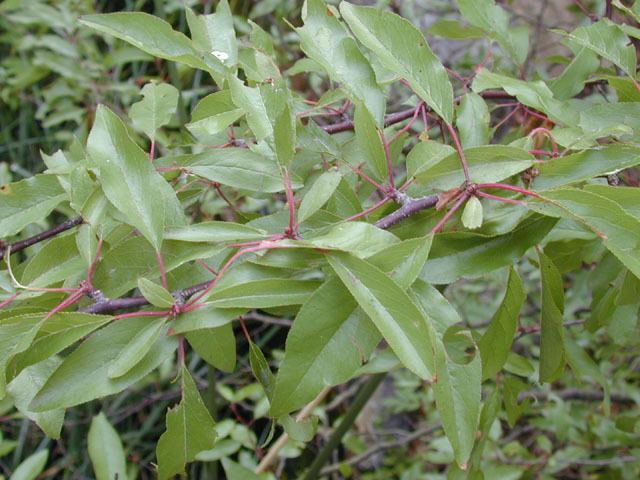Kingdom Plantae Rank Species | Genus Prunus Section Prunocerasus | |
 | ||
Similar Prunus gracilis, Prunus hortulana, Prunus texana, Prunus geniculata, Prunus umbellata | ||
Prunus rivularis, known variously by the common names creek plum, hog plum, or wild-goose plum is a thicket forming shrub. It prefers calcareous clay soil or limestone-based woodland soils. This deciduous plant belongs to the rose family Rosaceae, and is found mainly in the central United States. It is a shrub consisting of slender stems with umbel clusters of white blossoms. The fruit is a drupe that resembles a large berry; though it has a bitter taste, it serves as a source of food for birds and other wildlife. "Prunus" is Latin for plum, whereas "rivularis" means being near a stream.
Contents
Description
The leaves are simple and alternately arranged along the stems. The general shape of the leaf ranges between elliptic and ovate and is gauged out to be 5-6 centimeters (2.0-2.4 inches) long and 2-3 centimeters (0.8-1.2 inches)wide. The base shape of the leaf is considered cuneate while the apex is acuminate. The margin or edges is described as serrate; usually with 10-11 teeth per centimeter. Flowers of this plant usually blossom around March to April. The inflorescence type is considered as raceme, where there are flower spikes from stalks that pawn out from the stem. The flowers themselves stretch in entirety of 12-16 millimeter. They occur in clusters of 2 to 8 on leaf axils. The pedicels on which the flowers are attached to are measured out of around 15-16 millimeter. They have a green and glabrous (without hair and smooth) surface. The hypanthium is considered as the floral tube. (Fusion of sepals, petals and stamen fused in a tube) Prunus rivularis is defined as a perigynous plant. (major parts of the flower are aligned with a superior ovary) The hypanthium’s length and width is measured out to be 2 to 2.5 millimeters respectively; and they are considered glabrous. (Surface devoid of hairs) The calyx lobes, or sepals of a flower, are found in a cluster of 5. The sepal has an oblong leaf shape and is measured 2 millimeters. The apex has a flat tip or truncate shape. There is a sugar producing gland at the tip in which the leaves cup around. Interesting to note that the margins ciliate (have fine tiny hairs) and the sides are pubescent. (Have short hairs) There are 5 white petals that are measured with a length of 5 millimeters. The petal margins are cupped and have an undulated (wavy) shape. There are on average of 20 stamen; the filaments are long and slender, 4-6 millimeter long while the anthers have a yellowish tint. The stamen is planted on the base of the hypanthium where the ovary is placed in the superior position. The ovary has a dark green hue and is measured 1-1.5 millimeter long while the style is white and is measured 5-6 millimeter long. The fruit of the ripens in late July. It is a drupe with a stony endocarp, fleshy mesocarp and soft exocarp. They can appear alone or in a cluster of 2 or 3 other fruits. The pedicel that stems from the fruit is slender and glabrous, measured to be 13-16 millimeters long. The fruit shape is globular and has an orangeish-reddish tint. It is 17-22 millimeters long as it is wide. It has a very juicy mesocarp, though it is quite bitter in taste. The endocarp is 9-11 millimeters wide and 13-15 millimeters thick.
Distribution and habitat
Prunus rivularis is native to the United States; found in Arkansas, southern Illinois, south-eastern Kansas, Kentucky, northern Louisiana, Mississippi, Missouri, south-western Ohio, Oklahoma, Tennessee, and Texas. It can be found in a variety of places in nature: places like creeksides, wooden canyons, bottom of valleys and flooded plains. This plant grows on limestone-based woodland or sandy soil. The moisture of the soil can vary between dry and moist, though the soil has to be well drained. (In other words, water is readily removed from the soil). The preferred pH is slightly more alkaline (greater than 7.2). It is hardy to levels of 6-9 because of its varied distribution. This implies that the USDA zones, or geographically designated zones of temperature of which plants can grow under, are found in the southern part of United States. The temperature ranges between -10° and 30° Fahrenheit. Again, because of the range of dispersion, the amount of precipitation this plant can experience is anywhere from 24 to 48 inches per year.
Ecology
Prunus rivularis is considered perennial, in which it can survive for more than two or more years. The fruits produced are usually consumed by birds and other mammals. The flowers are known to attract insects such as butterflies and bees.
Medicinal
All members of the Prunus genus contain amygdalin and prunasin. These compounds are found in leaves and seeds. These substances can form hydrogen cyanide through subsequent reactions in water.
Usage
The leaves can be used to produce dyes ranging from green to dark grey.
The fruit was eaten by native American Indians in Texas.
